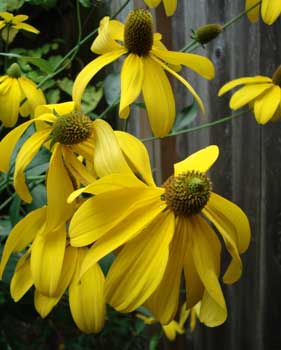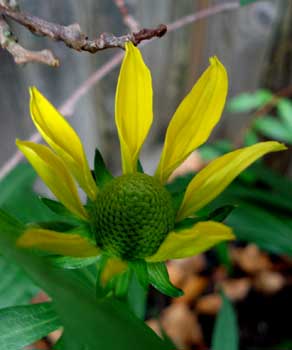
Cutleaf Yellow Coneflower
"That beautiful season the Summer!
Filled was the air with a dreamy & magical light;
And the landscape
Lay as if new created in all the freshness of childhood."
-Henry Wadsworth Longfellow
(1807-1882)
With so many of American gardens populated by choice perennials from China, India, Europe, & from everywhere in the world, it's nice to remember sometimes that our native species are among the most beautiful, vigorous, & thrilling. Gardeners who elect to present only native species are by no means getting something less flashy by avoiding the exotic.(1807-1882)
Rudbeckia laciniata is widespread & common throughout the United States, except in California, Oregon, Utah & Arizona, as well as throughout most of Canada except the very center, & not in the far north or Alaska.
With such an extensive range ithas accumulated many regional names, with Cutleaf Coneflower the closest to a standard common name.
Other names include Tall Yellow Coneflower because flower stems can reach eight feet of height or higher; Tall Thimbleweed; & Cone-disk Sunflower. It's known as Wild Goldenglow because of the extreme brightness of its large yellow blooms, with yellow-green cones; for the cones, it's sometimes known as Green-headed Coneflower.
The basal leaves have a pleasant balsamic odor. The species name alludes to the leaves being pinnately divided, as does the name Cutleaf. The leaves are excellent raw in salads if harvested small & in spring, but they're too tough by summer.
The roots are used medicinally in the same manner as echinacia, even though without proven value. It is reported in William Cook's 1869 Physiomedical Dispensatory that a tonic or hot herbal tea of Cutleaf Coneflower will relieve the effects of prostate disease, kidney & urinary problems, menstrual cramping, & general torpor.
It's a wetlands native commonest in flood plains, along streams, & soggy thickets. Purportedly it cannot abide droughtiness though doing spectacularly well in averagely moist soil.
 However, we've had it growing for many years in a droughty corner where its roots are always shaded by shrubs & vines but it invariably sends up its amazingly tall stems with loads of flowers. This is the rainy Northwest of course, but our summers can be shockingly dry, & our experience with this one plant is that it does just fine with little water so long as the roots aren't directly sunned.
However, we've had it growing for many years in a droughty corner where its roots are always shaded by shrubs & vines but it invariably sends up its amazingly tall stems with loads of flowers. This is the rainy Northwest of course, but our summers can be shockingly dry, & our experience with this one plant is that it does just fine with little water so long as the roots aren't directly sunned.Our one clump has never successfully self-seeded though they easily do so. I assume seedlings much more than mature plants cannot abide droughty periods or we'd have more of them popping up. Small birds like to cling to the cones in autumn, & pick out the small fang-shaped seeds.
It is perhaps taller & floppier than it would be in a better watered garden without shrubs to reach above for the full sun it requires. Though it lodges (falls over) all too easily, because it's hemmed in by kiwi vines, it manages to find itself braced more or less upright & we never stake it.
Reflexed summer blooms start in July & persist to September with deadheading, sometimes later; the lowermost photo is from one of the last flowers of October. In the southwest & inland it can begin blooming as early as May.
Petals start out with slim upright petals, but as they mature, they become strongly reflexed. The tall stems branch out so that the flowers occur in groups. It's obviously superb for cut flower arranging. And the cones, sans petals, can be dried for dry floral arrangement.
Continue to:
Rudbeckia fulgida var sullivantii 'Goldsturm'